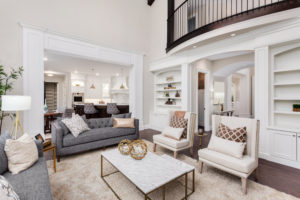What’s the Best Way to Choose a Paint Finish for Your Space?

When you hear people toss around the words “paint finish” you may wonder what, exactly, they mean and why they’re important. We’ll unravel the mystery of paint finishes and help you pick the right painting tools to make the most of each type.
But First, What’s a Paint Finish?
Before we jump into wall materials, tools and techniques, let’s define what paint finish means. In short, a finish is the paint’s texture after it dries and how much light it bounces off the wall, which means it could be flat and velvety or shiny and smooth.
Introducing the Five Finishes
Are you standing in the paint aisle, wondering which paint to choose? Here’s where knowing the full range of options can help. There are five paint finishes. They are:
- Eggshell – Eggshell has a soft look, similar to an eggshell. This finish is still considered low gloss, but it’s more reflective than flat paint.
- Flat (or Matte) – Flat paint minimizes the light reflected by the paint’s surface.
- Gloss – Gloss finish has the highest level of reflectivity, which makes it a rare choice for walls.
- Satin – Satin finish reflects more light than eggshell and flat.
- Semigloss – Semigloss is a step up on the reflective scale, giving surfaces a slightly shiny look.
Picking the Right Paint Finish for the Space
Since each finish has its own characteristics, matching it to the right surface is important. Here’s a breakdown of how to choose the right finish for your space.
Flat finish masks any dings or rough spaces in the walls, but its lack of sheen makes it harder to clean. This velvety surface works well in living rooms and dining rooms or other areas that get less traffic.
Thanks to that slightly higher sheen, eggshell it’s easier to clean and more durable than flat. Still considered a low-gloss sheen, it’s susceptible to humidity, so avoid using it in bathrooms and kitchens.
Satin is the most commonly used finish because it smooths out imperfections in walls, but it’s also easier to clean than its less shiny counterparts.
Reserve semi-gloss for high-humidity rooms like bathrooms and kitchens because it resists moisture. Its high reflectivity means you’ll see every imperfection in the wall, though, so start with a perfectly smooth surface.
Gloss paint is most commonly used on cabinets, molding and doors. It’s extremely durable and easy to clean, with a sheen more like an oil paint. While some designers use it to achieve a mirror-like look, it requires a high-maintenance, professional paint job to get just the right look.
The Right Tools for the Finish
For most paints, a roller is exactly the right tool for the job. Flat, eggshell and satin all look best when rolled on with a low-nap paint roller, which gives the paint a uniform surface.
When using glossier paints, we recommend a foam roller for large areas or a paint brush for cabinet doors and trim. Start with a uniform surface – carefully patched and perfectly sanded – for the best results.
And just a note: If you’re painting one finish over another, you can go up the glossy scale but not down. So, if you’re painting flat over a glossier paint finish, you’ll need to prep and prime or else the paint will chip and crack. If you’re painting any glossier paint over a flatter paint, the paint will adhere just fine.
Got more questions about paint finishes? Find an interior house painter in your area through our painting service. They’re ready to help.
